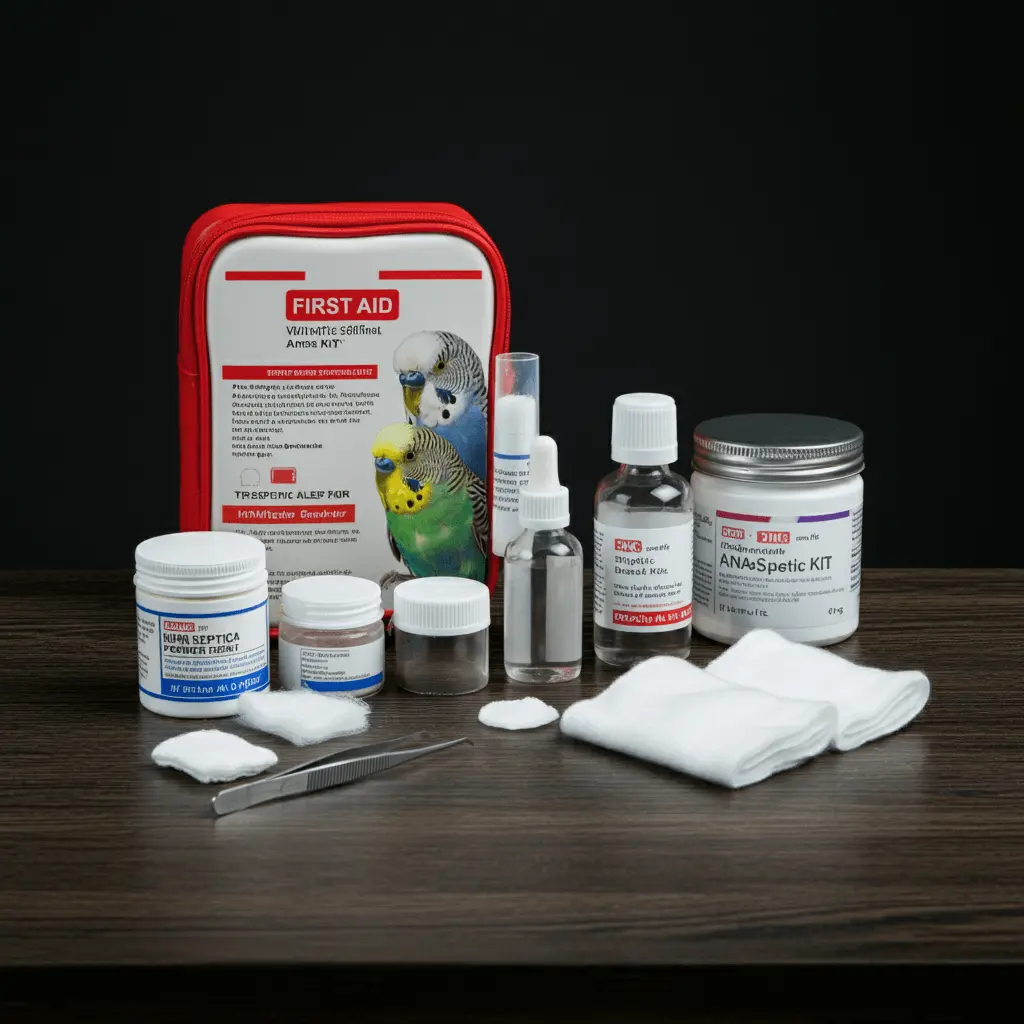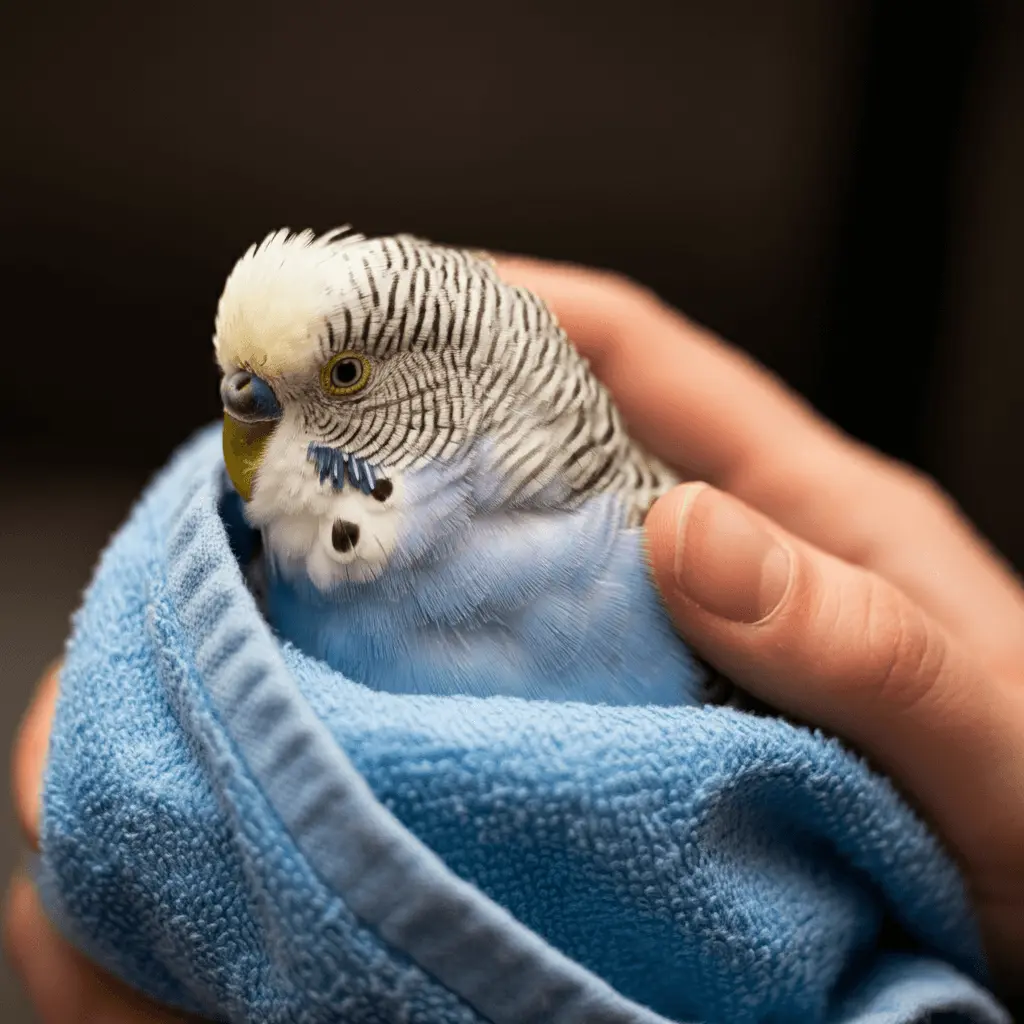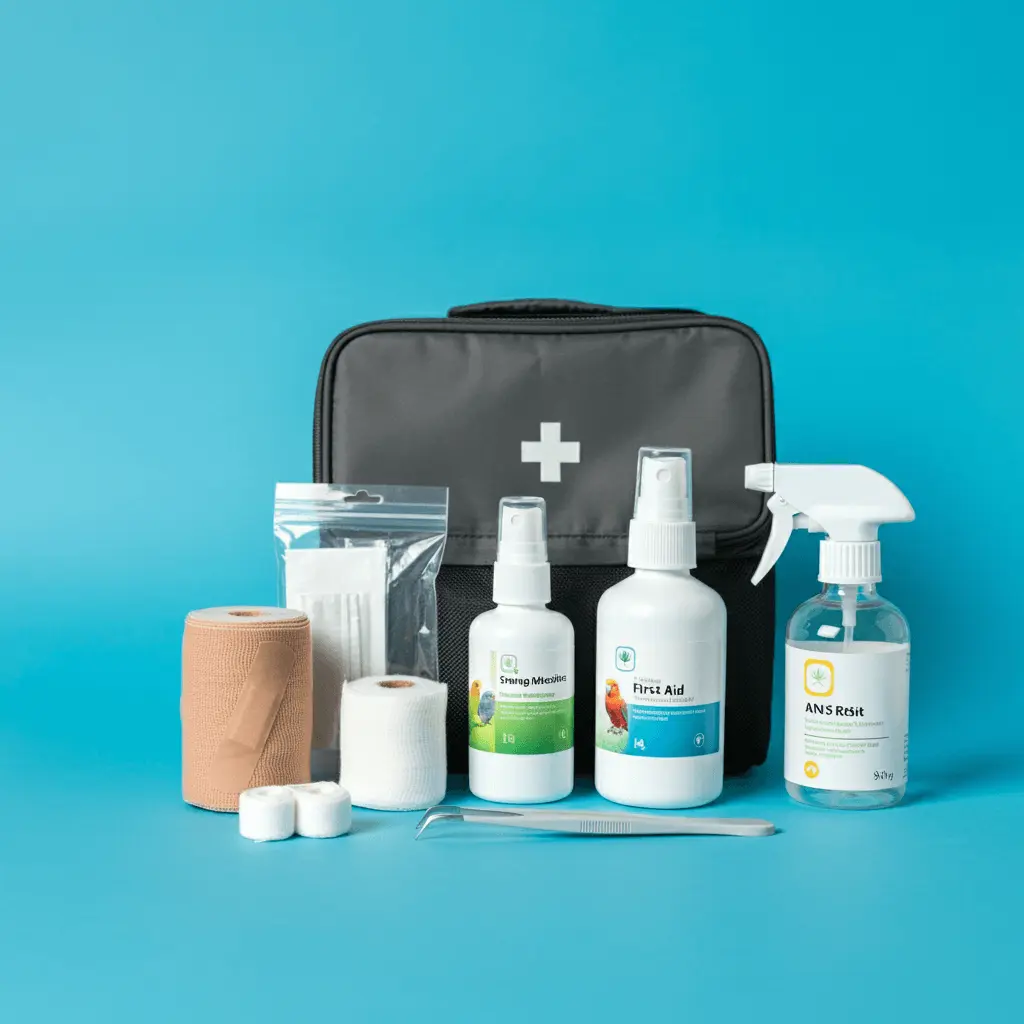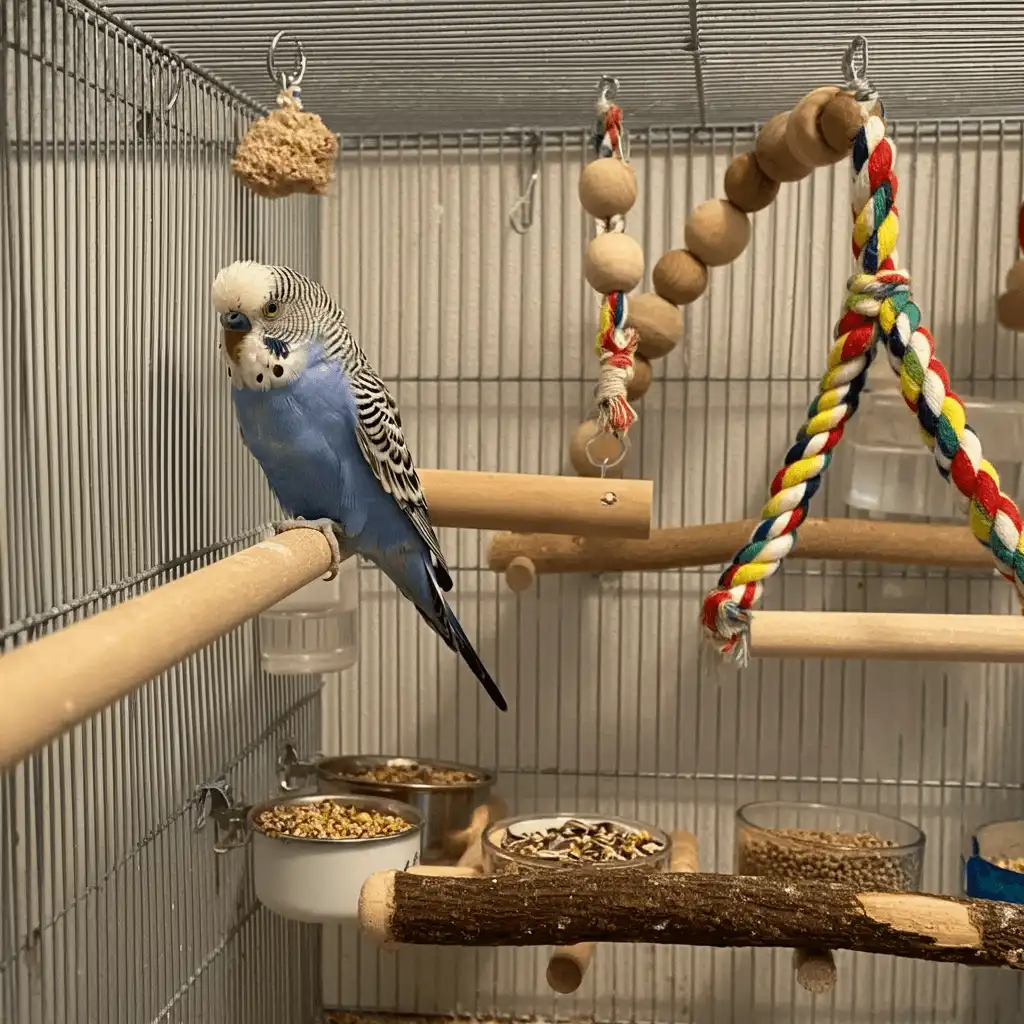Understanding the Basics of Budgerigar First Aid
When it comes to caring for your budgerigar, being prepared for emergencies is crucial. Knowing the basics of budgerigar first aid can make a significant difference in how well your bird recovers from an injury or health issue. Whether it’s a minor injury or a serious emergency, having the right knowledge and tools at your disposal can save your budgie’s life.
Budgerigars, like other birds, are prone to various health problems, from minor cuts to more severe conditions like fractures or respiratory issues. The first step in budgie emergency care is recognizing the signs that something is wrong. Watch for changes in behavior, difficulty breathing, or visible injuries. These can all be indicators that your budgerigar needs immediate attention.
A well-stocked first aid kit for budgerigars is a must-have for any bird owner. This kit should include items like antiseptic solution, sterile gauze, tweezers, and styptic powder, which helps stop bleeding. These essentials will help you manage common injuries, such as cuts or broken blood feathers, until you can get your bird to a vet.

A complete first aid kit designed specifically for budgerigars, featuring all essential medical supplies for emergency care.
Understanding budgie first aid basics also involves knowing when you can handle a situation on your own and when it’s time to seek veterinary help. While it’s important to be able to provide immediate care, there are times when professional intervention is necessary, especially if your bird’s condition doesn’t improve quickly or if the injury is severe.
By being proactive and learning bird first aid essentials, you’re not only preparing yourself for emergencies but also ensuring that your budgerigar has the best chance of a swift recovery. Regularly updating your knowledge and keeping your bird first aid kit well-stocked are key practices that every responsible budgie owner should follow.
Understanding these basics can make all the difference in an emergency, helping you to act quickly and effectively when your budgerigar needs it most.
Common Budgerigar Emergencies and How to Handle Them
As a budgerigar owner, it’s essential to be aware of common emergencies that could threaten your bird’s health and know how to respond swiftly. Whether it’s an injury or a sudden illness, being prepared can make all the difference in your budgie’s recovery.
Bleeding Feathers: One of the most common emergencies is bleeding from a broken blood feather. These feathers have a blood supply, and if broken, they can cause significant bleeding. To handle this, gently restrain your budgie, and use a pair of tweezers to carefully remove the broken feather from the base. Apply styptic powder or cornstarch to stop the bleeding. If the bleeding doesn’t stop, seek veterinary assistance immediately.
Respiratory Distress: Budgerigars are prone to respiratory issues, which can be life-threatening if not addressed quickly. Signs of respiratory distress include open-mouthed breathing, tail bobbing, or wheezing. If you notice any of these symptoms, place your budgie in a warm, quiet environment, and contact a vet as soon as possible. Avoid exposing your bird to drafts or smoke, which can exacerbate the problem.
Injuries from Falls or Collisions: Budgies are active and curious, sometimes leading to falls or collisions with windows or mirrors. If your budgie has a minor injury, like a sprained wing or leg, keep them in a small, quiet cage to restrict movement and allow them to heal. For more serious injuries, such as fractures or head trauma, immediate veterinary care is required.
Poisoning: Budgerigars are curious by nature, which sometimes leads them to ingest harmful substances like toxic plants, household cleaners, or even certain foods. If you suspect poisoning, remove the source immediately and contact your vet. Activated charcoal can sometimes be used to absorb toxins, but this should only be done under veterinary guidance.
Crop Stasis: Crop stasis occurs when food remains in the crop and doesn’t pass into the stomach, causing the crop to become swollen and possibly infected. This can be caused by improper diet, dehydration, or infection. If you notice a swollen crop or your budgie seems lethargic and uninterested in food, seek veterinary help right away. In the meantime, ensure your bird is warm and hydrated.
Egg Binding: Female budgerigars may occasionally suffer from egg binding, where an egg becomes stuck and the bird is unable to lay it. Signs include straining, sitting fluffed up, and a swollen abdomen. This is a life-threatening condition that requires immediate veterinary care. In the meantime, you can provide warmth and humidity by placing your budgie in a steamy bathroom.

A budgerigar being gently restrained in a soft cloth to ensure safe and effective first aid treatment during emergencies.
Handling these emergencies with confidence and knowledge can dramatically improve your budgerigar’s chances of recovery. Always have a bird first aid kit on hand and familiarize yourself with basic budgie first aid techniques so you’re prepared for any situation that arises.
Essential First Aid Kit for Budgerigars
Having a well-prepared first aid kit is essential for any budgerigar owner. It’s the first line of defense in case of an emergency, allowing you to provide immediate care before getting your bird to a vet. Here’s what you need to include in your budgerigar first aid kit to ensure you’re ready for any situation.
1. Styptic Powder: This is a must-have for stopping bleeding, especially from broken blood feathers. If your budgie has a minor cut or starts bleeding, applying styptic powder can quickly stop the blood flow. Cornstarch can also be used as a substitute in a pinch.
2. Tweezers: A good pair of tweezers is essential for removing broken feathers, splinters, or small foreign objects from your bird’s skin. Make sure they’re fine-tipped and sterilized to prevent infection.
3. Antiseptic Solution: Keeping an antiseptic, like betadine or a bird-safe iodine solution, is important for cleaning wounds and preventing infections. It’s vital to avoid alcohol-based antiseptics, as they can be too harsh for a budgie’s delicate skin.
4. Gauze Pads and Bandages: Sterile gauze pads are useful for applying pressure to wounds or for covering an injury to keep it clean. Vet wrap or self-adhesive bandages are great for securing gauze in place without sticking to your bird’s feathers.
5. Scissors: A small pair of rounded-tip scissors should be included in your first aid kit for cutting gauze, bandages, or trimming feathers around a wound. Ensure they’re kept sharp and clean.
6. Eye Dropper or Syringe: These are handy for administering fluids or medications, particularly if your budgie is dehydrated or needs a precise dose of medicine. A syringe without a needle is safe and easy to use.
7. Activated Charcoal: If your budgerigar ingests something toxic, activated charcoal can help absorb the toxin while you’re on your way to the vet. However, this should only be administered under veterinary guidance.
8. Heat Source: A small heat pad or heat lamp can be crucial if your budgie goes into shock or needs to stay warm after an injury. Keeping your bird warm is often one of the most important steps in first aid.
9. Emergency Contact Information: Always have your avian vet’s contact information readily available in your first aid kit. In an emergency, quick access to professional help can be life-saving.
10. Bird-Safe Disinfectant: Keeping a disinfectant spray that’s safe for birds is important for cleaning your budgie’s cage or any surfaces that come into contact with wounds or illnesses.

Key contents of a budgerigar first aid kit, including disinfectants, bandages, and emergency spray, all laid out on a blue background.
A well-stocked first aid kit for budgerigars is a small investment that can make a big difference in an emergency. Keep it in an accessible place, regularly check to ensure all supplies are fresh and in good condition, and familiarize yourself with how to use each item. By being prepared, you’ll be able to act quickly and effectively if your budgerigar needs immediate care.
How to Perform Basic First Aid on a Budgerigar
When your budgerigar faces an emergency, knowing how to perform basic first aid can be the difference between a quick recovery and a more serious outcome. While it’s always best to consult with an avian vet, there are certain steps you can take immediately to stabilize your bird before professional help arrives.
1. Handling Your Budgerigar Safely
The first step in any emergency is to gently but securely restrain your budgie. Birds can be fragile and easily stressed, so use a soft towel to wrap your bird, leaving the head exposed. This prevents flapping and minimizes the risk of further injury. Always handle your bird with care to avoid causing additional stress or harm.
2. Stopping Bleeding
If your budgerigar is bleeding, particularly from a broken blood feather or a minor cut, you’ll need to act fast. Use styptic powder or cornstarch to stop the bleeding. Apply a small amount directly to the wound using a cotton swab or your fingertip. Apply gentle pressure until the bleeding stops. If the bleeding doesn’t stop after a few minutes, it’s essential to get your budgie to a vet immediately.
3. Treating a Broken Feather
Broken feathers can be painful and lead to bleeding. If a feather is broken near the base and is bleeding, it needs to be removed. Using fine-tipped tweezers, grip the feather close to the skin and pull it out with a firm, quick motion. This helps prevent further bleeding and allows a new feather to grow in its place. Afterward, apply a bit of antiseptic to the area to prevent infection.
4. Handling Respiratory Distress
If your budgie is showing signs of respiratory distress, such as labored breathing or wheezing, place them in a warm, humid environment. You can use a steamy bathroom or a humidifier. Keep your bird calm and quiet, and avoid handling them too much, as this can worsen their condition. Contact your avian vet as soon as possible for further treatment.
5. Addressing Minor Injuries
For minor injuries, such as small cuts or bruises, clean the area with a bird-safe antiseptic solution. Use sterile gauze to gently wipe away any dirt or debris. If the injury is on a limb, you can use a small piece of gauze and vet wrap to create a soft bandage. Ensure that the bandage isn’t too tight, as this can restrict blood flow.
6. Managing Shock
If your budgie has experienced trauma, they may go into shock. Signs of shock include weakness, rapid breathing, and a fluffed-up appearance. To manage shock, keep your bird warm by wrapping them in a soft towel and placing them near a heat source, such as a heating pad or lamp (not too close). Minimize handling and provide a quiet, dark environment until you can reach a vet.
7. Poisoning Response
If you suspect your budgerigar has ingested something toxic, contact your vet immediately. While waiting for professional help, you can offer your bird activated charcoal mixed with water, as it can help absorb some toxins. However, this should only be done under veterinary guidance. Remove any remaining poison from the environment and keep your bird warm and calm.
Performing basic first aid on a budgerigar requires a calm demeanor and quick action. By being prepared and knowing how to address these common emergencies, you can provide your budgie with the best possible care when they need it most. Remember, while these first aid steps are crucial, they are not a substitute for professional veterinary care. Always follow up with your avian vet to ensure your bird makes a full recovery.
Recognizing When to Seek Veterinary Help
While knowing how to perform basic first aid on your budgerigar is essential, there are times when professional veterinary care is absolutely necessary. Recognizing when to seek veterinary help can be the key to saving your bird’s life. Here’s how to know when it’s time to call the vet.
1. Persistent Bleeding or Severe Injuries
If your budgerigar is bleeding and the bleeding doesn’t stop after applying styptic powder or cornstarch, it’s time to seek veterinary help. Persistent bleeding can lead to serious complications, such as blood loss and shock. Similarly, if your bird has a severe injury, like a broken bone or deep cut, professional care is essential to ensure proper treatment and healing.
2. Respiratory Distress
Respiratory issues in budgerigars are serious and often require immediate veterinary attention. Signs such as open-mouth breathing, wheezing, tail bobbing, or unusual vocalizations can indicate a respiratory problem that needs professional intervention. These symptoms can worsen quickly, so it’s crucial to get your bird to a vet as soon as you notice them.
3. Signs of Infection
If your budgerigar has a wound that becomes swollen, red, or starts oozing pus, these are signs of infection. Infections can spread rapidly in birds and may lead to more serious health issues. If you suspect your bird’s injury is infected, contact your vet for proper antibiotics or other treatments.
4. Lethargy and Unusual Behavior
Budgerigars are typically active and social birds. If you notice your budgie is unusually quiet, fluffed up, sitting at the bottom of the cage, or seems disinterested in food and water, these can be signs of a serious health problem. Lethargy and behavioral changes are often early indicators of illness, and seeking veterinary help immediately can prevent the condition from worsening.
5. Difficulty Laying Eggs (Egg Binding)
Female budgerigars can sometimes experience egg binding, where an egg becomes stuck inside the bird and cannot be laid naturally. This is a life-threatening condition that requires immediate veterinary intervention. Signs include straining, a swollen abdomen, and sitting fluffed up at the bottom of the cage. If you suspect egg binding, do not attempt to treat it at home—get to a vet right away.
6. Ingestion of Toxic Substances
If your budgerigar has ingested something toxic, such as certain plants, chemicals, or foods that are harmful to birds, you should seek veterinary help immediately. Symptoms of poisoning can include vomiting, diarrhea, seizures, or sudden weakness. Quick action is critical, so contact your vet and provide as much information as possible about what your bird may have ingested.
7. Persistent Vomiting or Diarrhea
While occasional vomiting or diarrhea might not be alarming, persistent symptoms can indicate a serious underlying issue, such as an infection or poisoning. If these symptoms continue for more than a few hours, it’s important to have your budgie checked by a vet to determine the cause and receive appropriate treatment.
Knowing when to seek veterinary help is crucial in ensuring your budgerigar’s health and well-being. While basic first aid can address many minor issues, there are situations where professional care is the only way to ensure your bird’s recovery. Trust your instincts—if something doesn’t seem right with your budgie, don’t hesitate to consult your avian vet. Prompt action can make all the difference in your bird’s health and happiness.
Preventing Accidents and Injuries in Budgerigars
Preventing accidents and injuries is one of the most effective ways to ensure your budgerigar lives a long and healthy life. While it’s impossible to eliminate all risks, taking a few proactive steps can significantly reduce the chances of your budgie getting hurt. Here’s how you can create a safer environment for your feathered friend.
1. Safe Cage Setup
A properly set up cage is the foundation of budgerigar safety. Choose a cage that is spacious enough for your budgie to fly short distances and climb around. The bars should be spaced close enough to prevent your bird from getting its head or wings stuck. Ensure that perches are made of safe, non-toxic materials and are placed at varying heights to prevent falls. Avoid placing food and water dishes directly under perches to keep them clean and free from droppings.

A safe and well-equipped bird cage setup, complete with perches, toys, and essential accessories, ensuring the well-being of a budgerigar.
2. Supervised Out-of-Cage Time
Budgerigars need regular out-of-cage time to stay healthy and happy, but this should always be supervised. Before letting your budgie out, bird-proof the room by covering mirrors and windows, closing doors, and removing any dangerous objects. Fans should be turned off, and open water sources, such as toilets or sinks, should be covered to prevent accidental drowning. Supervision ensures that your budgie doesn’t get into harmful situations while exploring.
3. Avoiding Toxic Substances
Many common household items can be toxic to budgerigars. Keep your bird away from plants like lilies, poinsettias, and avocado trees, which are poisonous to birds. Avoid using non-stick cookware that can release harmful fumes when overheated, and keep your budgie away from areas where chemicals, like cleaning products or insecticides, are used. Ensure that any food you offer your budgie is safe for birds; foods like chocolate, caffeine, and alcohol should be strictly avoided.
4. Safe Playtime Practices
Budgies love to play, and providing safe toys is crucial. Choose toys made from bird-safe materials, such as untreated wood, stainless steel, or bird-safe plastic. Avoid toys with small parts that could be swallowed or cause choking. Regularly inspect toys for wear and tear, and replace them if they become damaged. Rotate toys to keep your budgie engaged and to prevent boredom, which can lead to destructive behavior.
5. Preventing Falls and Collisions
Falls and collisions are common causes of injury in budgerigars, especially in unfamiliar environments. When introducing your budgie to a new room or area, allow them to explore at their own pace. Close curtains or blinds to prevent your bird from flying into windows, and use decals or stickers to make glass surfaces more visible. If your budgie is flighted, consider trimming their wings slightly to reduce the risk of injury from high-speed collisions, though this should be done carefully and ideally by a professional.
6. Regular Health Checks
Regularly checking your budgie for signs of injury or illness can help prevent minor issues from becoming major problems. Look for any changes in behavior, appetite, or appearance, such as ruffled feathers or lethargy. Keep an eye on their feet and beak for any signs of overgrowth or injury. If you notice anything unusual, consult your avian vet promptly to address any potential issues before they escalate.
7. Creating a Stress-Free Environment
Stress can lead to accidents and injuries, as a stressed budgie is more likely to behave erratically. Ensure that your budgerigar’s environment is calm and consistent, with a regular routine for feeding, cleaning, and playtime. Avoid sudden loud noises, abrupt changes in the environment, or introducing new pets or people without a gradual acclimation process.
By taking these preventative measures, you can greatly reduce the risk of accidents and injuries in your budgerigar. A safe and secure environment, combined with attentive care, will help ensure that your budgie enjoys a healthy and happy life. Remember, prevention is always better than cure, and these small steps can make a big difference in your bird’s well-being.
Frequently Asked Questions (FAQs)
Q1: What should I do if my budgerigar is bleeding?
If your budgerigar is bleeding, the first step is to remain calm and act quickly. Apply styptic powder or cornstarch to the bleeding area to help stop the blood flow. Gently apply pressure using a sterile gauze pad until the bleeding subsides. If the bleeding doesn’t stop after a few minutes, it’s important to seek veterinary help immediately, as excessive blood loss can be dangerous for your budgie.
Q2: What should I include in a budgerigar first aid kit?
A well-prepared budgerigar first aid kit should include essentials like styptic powder, tweezers, antiseptic solution, sterile gauze, vet wrap, scissors, an eye dropper or syringe, activated charcoal, and a heat source. Having these items on hand can help you manage minor injuries and stabilize your budgie in an emergency until you can reach a vet.
Q3: How can I tell if my budgerigar needs veterinary attention?
There are several signs that indicate your budgerigar may need veterinary care. These include persistent bleeding, respiratory distress (such as wheezing or open-mouth breathing), signs of infection (like swelling or oozing), unusual lethargy, and difficulty laying eggs (egg binding). If your budgie displays any of these symptoms, it’s crucial to seek professional veterinary help as soon as possible.
Q4: How can I prevent accidents and injuries in my budgerigar?
Preventing accidents and injuries starts with creating a safe environment for your budgie. Ensure their cage is set up properly with safe perches, toys, and food placement. Supervise out-of-cage time, and bird-proof the room by covering mirrors, windows, and other hazards. Regular health checks and avoiding toxic substances also play a key role in keeping your budgerigar safe and healthy.
Q5: What should I do if my budgerigar ingests something toxic?
If you suspect your budgerigar has ingested something toxic, contact your avian vet immediately. While waiting for professional help, you can offer your budgie activated charcoal mixed with water to help absorb the toxin, but this should only be done under veterinary guidance. Remove any remaining toxic substances from the environment and keep your bird calm and warm.
Q6: Can I perform first aid on my budgerigar at home?
Yes, you can perform basic first aid on your budgerigar at home for minor injuries and health issues. However, it’s important to know your limits and recognize when professional veterinary care is necessary. Basic first aid can help stabilize your budgie, but always follow up with your avian vet to ensure proper treatment and recovery.
These FAQs should help you feel more prepared and confident in providing first aid to your budgerigar. Remember, the key to effective emergency care is staying calm, acting quickly, and knowing when to seek professional help.
Conclusion: Be Prepared for Any Budgerigar Emergency
Being a responsible budgerigar owner means being prepared for any emergency that may arise. While it’s impossible to predict every situation, having a solid understanding of budgerigar first aid and keeping an emergency kit on hand can make a significant difference in your bird’s health and recovery.
From understanding the basics of budgerigar emergency care to recognizing when it’s time to seek veterinary help, preparation is key. A well-stocked first aid kit, combined with the knowledge of how to use it, ensures that you’re ready to handle common injuries, respiratory issues, and other urgent health problems that your budgie might encounter.
Preventing accidents and injuries by creating a safe environment is equally important. Regularly checking your budgerigar’s health, supervising out-of-cage time, and being aware of potential hazards can help keep your feathered friend safe and sound.
In the end, the best way to ensure your budgerigar’s well-being is to stay informed, vigilant, and ready to act. Emergencies can be stressful, but with the right preparation, you’ll be able to provide the immediate care your budgie needs, giving them the best chance at a quick and full recovery. Remember, your readiness to respond swiftly and effectively could be the difference between a minor scare and a serious situation.

